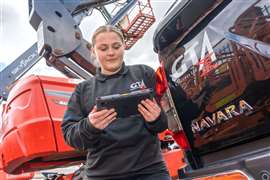Telescopic crawlers: A rising demand
22 June 2015

The popularity of the telescopic crawler crane continues to rise as new applications are found and products are refined and further developed. Laura Hatton finds out more
Telescopic crawler cranes are commonly used by contractors in the power line industry or for carrying out jobs at plants. Due to its mobility, however, the scope of work for this crane type is expanding and telescopic crawler cranes are being used for a range of applications. Scott Knight, Link-Belt product manager, lattice and telescopic crawler cranes, says, “The list of crane applications for telescopic crawler cranes is growing. What was once considered a niche product category designed mostly for the power line industry has expanded into everything from steel erection to bridge work and panel placement.”
The reason behind this growth in popularity is largely down to the mobility that telescopic crane types offer. Compared to similar types, such as lattice boom crawlers, telescopic crawler cranes need less space for rigging and importantly they can drive with a load on the hook. As Knight points out, this ability to pick and carry provides a new set of solutions for customers and contractors.
Mike Herbert, Manitowoc global product director for rough terrain cranes, adds, “The cranes offer the benefits of small crawler cranes with the versatility of telescoping booms and due to their compact dimensions and transportability, they can save time and money for contractors and end users.”
Latest models
To keep up with the growing list of applications, manufacturers are producing higher capacity models, all with good pick and carry capabilities. From German manufacturer Sennebogen, for example, is the new 120 tonne capacity 6113 telescopic crawler. The 6113 is the largest telescopic crawler crane manufactured by Sennebogen to date and offers a 40 metre, four section full power telescopic boom, which can be extended to 70 m when combined with a fly jib and lattice boom extension.
“Thanks to multi-cylinder technology, this maintenance-free system enables continuous telescoping and is always friction-locked,” the manufacturer told IC. “With the 6113, the boom can work variably and quickly at any length.”
The 6113 is capable of moving with a load and can work on inclines up to 4 degrees. It has 8 m heavy duty track frames and 900 mm wide tracks. In addition, the undercarriage can be telescoped out to a track width of 5.4 m. Other features include an elevating work platform with a load-bearing capacity of up to 1 tonne, Maxcab, LED headlights and cameras. Power comes from a Tier 4 Final 168 kW Deutz engine. For ease of transport, the 6113 can be transported in sections and set up on site in 12 steps, the manufacturer said.
Staying at the top end of the capacity scale from Liebherr is the LTR 1220. The crawler has a 220 tonne capacity at 3 m, a 60 m main boom and can be configured with a 43 m lattice jib. It has 70 tonnes of superstructure ballast, 20 tonnes of central ballast and can move under full load, the manufacturer says. In addition, it has Variobase base for off-road capability.
Wolfgang Beringer, Liebherr-Werk Ehingen Liebherr sales promotion, says, “The LTR 1220 combines the advantages of a telescopic crane with those of a crawler crane. The crawler travel gear provides excellent off-road capacity and superb manoeuvrability, as well as allowing the crane to travel under full load. The advantages of a telescopic crane over a lattice boom crane are the short set-up times, easy transport and the variability of the boom system. The telescopic boom can be automatically extended or retracted to the desired length, allowing it, for example, to pass easily beneath obstacles.”
New from Tadano Mantis is the 120 tonne capacity GTC-1200. It has a five-section, 47.2 m full power boom and can be configured with a 32 m jib. The GTC-1200 is fitted with the Tadano AML-C rated capacity indicator system, track position sensing and swing angle sensing for crane setup and position and the Tadano HelloNet Telematics management tool. The new GTC-1200 has the capability to pick and carry the full load chart, work out of level, and work with a full range of foundation tools, the manufacturer adds.
New for the Americas from manufacturer Manitowoc is a trio of compact telescoping crawler cranes built by German manufacturer Sennebogen. The three Grove-branded models are the 55 US ton (50 tonne) capacity GHC55, the 77 ton (70 tonne) GHC75 and the 132 ton (120 tonne) GHC130.
The GHC55 has a 30.4 metre main boom. Total system length with boom retracted is 10.7 m and the crane's width with crawlers retracted is 3.5 m. Overall height is 3.2 m. On the GHC75 is a 36 m main boom. With it retracted the total length for transport is 13 m and it is 3.2 m wide with crawlers retracted. Overall height is 3.2 m. The GHC130 has a 40.2 m main boom. For transport the crane is 15.3 m long by 3.9 m wide and 4 m high overall. All three cranes have Tier 4 Final Cummins engines. Manitowoc will offer maintenance, service, spare parts and financing. For work on power line projects the GHC Series cranes include an auger and a pole claw attachments. Equivalent products from the Sennebogen product range (the Sennebogen 653, 673, and 6113) will not be offered in the Americas.
“The GHC series is for customers that need a compact, manoeuvrable crane that can face the rigors of merciless terrain,” Mike Herbert, says. “With minimal transport requirements, 100 per cent pick and carry ability and a telescoping boom these cranes will prove very nimble in both getting to and navigating job sites.”
Popular capacities
From US manufacturer Link-Belt is the TCC-500 which joined the 70 tonne capacity TCC-750 and the 100 tonne capacity TCC-1100 to complete the line-up of Link-Belt telecrawlers. The TCC-500 has a four-section, full-power boom and has a standard counterweight package of 11.3 tonnes. The model can be transported in most markets, while staying under 45.5 tonnes. It is powered by a Stage 4/Tier IV final Cummins QSB engine. A Stage IIIA/Tier III version is also available.
“The TCC-500 has a variable displacement piston pump package, which is designed to provide positive and precise control with independent or simultaneous operation of all crane functions, like when using an auger or pole claw attachment,” Knight adds. “The TCC-500 can also hydraulically extend its tracks for three working track gauges including fully extended, intermediate and fully retracted.”
New from Chinese manufacturer Fuwa is the 65 tonne capacity FWT 65 telescopic boom crawler crane. The FWT 65 has a 38 m pinned boom, which can be extended with 8 and 6 m jibs for a total extension of 14 m. Power comes from a 142 kW Cummins QSB6.7 diesel engine. It is designed for easy assembly, the manufacturer says. The model is the third generation series, following on from the second (60 tonne), which was launched at Bauma China 2012, in turn a development of the 55 tonne first series model.
From Italian manufacturer Marchetti are the Sherpa 70.42L and the Sherpina 25.35 crawler cranes. The 25 tonne capacity Sherpina 25.35 has a 25.1 m telescopic boom and a maximum hook height 33.2 m when fitted with a jib. The Sherpa 70.42L has a capacity of 70 tonnes and a 42 m boom. Maximum hook height is 58.5 m. The model has a transport width of 2.98 m and a variable undercarriage track from 2.98 to 4.6 m. In addition, it has radial type outriggers for support can be fitted with an impact hammer for pile driving. Power comes from a 175 kW diesel engine. Marchetti also has a new 60 tonne machine under design.
“The outriggers allow the telescopic crawler crane to start work immediately on un-prepared terrain or sloping ground without the need for earth works,” Italian manufacturer Marchetti says. “In addition, it can be transported without removing anything (neither tracks nor counterweight) saving time and money.”
At the lower end of the capacity scale are the LC383, LC785, and LC1385 mini crawler cranes from Maeda. The models have a capacity of 2.9, 4 and 6 tonnes, respectively. Main advantages are small size and the ability to work in limited or confined spaces. Full power booms, fully enclosed cabs with air conditioning are fitted on the larger models. Maximum width of the three models is 2.49 m. By September, all cranes from Maeda in the UK will have Tier-4 emission standard engines so will comply with UK regulations.






